Did you know that purple peppers are not only visually stunning but also packed with health benefits? These vibrant veggies have become increasingly popular among gardeners and food enthusiasts alike, adding a unique touch to dishes and gardens.
In this article, I will share expert advice on growing purple peppers, covering everything from choosing the right soil to harvest tips. Whether you’re a seasoned gardener or just starting out, these tips and tricks will help you cultivate healthy and vibrant purple peppers with confidence.
Key Takeaways:
- Growing purple peppers can add beauty and flavor to your garden.
- Purple peppers are rich in vitamins, minerals, and antioxidants, offering numerous health benefits.
- Choosing the right soil and starting seeds indoors are essential for successful purple pepper cultivation.
- Proper care, including adequate water, fertilization, and support, is crucial for healthy plant growth.
- Harvesting purple peppers at the right time ensures optimal flavor and encourages continuous production.
The Science Behind Purple Peppers
Purple peppers are not only visually stunning but also intriguing when it comes to their unique coloration. These vibrant veggies come in various varieties, including purple bell peppers, purple sweet peppers, and purple chili peppers. But what exactly gives them their eye-catching purple hue?
The secret lies in a class of natural pigments called anthocyanins. Anthocyanins are responsible for the vibrant purple, blue, and red colors found in many fruits and vegetables. They play a vital role in attracting pollinators and protecting plants from harmful UV radiation.
In the case of purple peppers, the purple coloration is a result of the presence of anthocyanins in their skin and flesh. These pigments accumulate in the cells of the pepper, giving it the unique shade of purple. The concentration and distribution of anthocyanins can vary, leading to different shades of purple in different varieties of purple peppers.
“Purple peppers get their unique color from anthocyanins, natural pigments found in fruits and vegetables.”
While purple peppers may be considered rare, they are gaining popularity among gardeners and food enthusiasts alike. Not only do they add a visually appealing touch to dishes, but they also offer a slightly different flavor compared to their green or red counterparts. The combination of sweet and mildly spicy flavor makes purple peppers a versatile ingredient in various cuisines.
In the next section, we will explore the health benefits of purple peppers, shedding light on their nutritional value and the positive impact they can have on your well-being.
Health Benefits of Purple Peppers
Purple peppers offer numerous health benefits due to their high nutritional content. They are rich in vitamins and minerals, particularly vitamin C, vitamin A, and potassium. These antioxidants help boost the immune system, promote healthy vision, and support proper heart function. Purple peppers also contain dietary fiber, which aids digestion and promotes a healthy gut.
To further illustrate the health benefits of purple peppers, here is a brief overview:
- Vitamin C: Purple peppers are an excellent source of vitamin C, an essential nutrient that supports immune health. Consuming foods rich in vitamin C can help strengthen your immune system, making you less susceptible to common illnesses and infections.
- Vitamin A: Purple peppers contain vitamin A, which plays a vital role in maintaining healthy vision. This nutrient helps preserve the integrity of your eyesight and protects against age-related macular degeneration.
- Potassium: Purple peppers are a good source of potassium, an electrolyte that helps regulate blood pressure and support proper heart function. Including potassium-rich foods in your diet, such as purple peppers, can contribute to a healthy cardiovascular system.
- Dietary Fiber: Purple peppers are also packed with dietary fiber, which plays a crucial role in digestive health. Fiber helps regulate bowel movements, prevents constipation, and promotes a healthy gut microbiome.
By incorporating purple peppers into your diet, you can enjoy these health benefits while adding a burst of vibrant color to your meals. Whether raw in salads or cooked in various dishes, purple peppers offer both visual appeal and nutritional value.
“Purple peppers are not only a feast for the eyes but also a nutritious addition to your plate. The vibrant color reflects the rich array of antioxidants and vitamins they house. Incorporating purple peppers into your diet can contribute to overall well-being and support a healthy lifestyle.”
To give you a visual representation of the nutritional content of purple peppers, here’s a table showcasing their key nutrients:
| Nutrient | Amount per 100g |
|---|---|
| Vitamin C | 80mg |
| Vitamin A | 3000 IU |
| Potassium | 250mg |
| Dietary Fiber | 2g |
Choosing the Right Soil for Purple Peppers
Growing healthy purple peppers starts with selecting the perfect soil. Purple peppers thrive in well-draining soil that is rich in organic matter. It’s crucial to provide them with the optimal growing conditions to ensure a bountiful harvest.
The first step is to find soil that drains well. Excess water can lead to root rot and other diseases, so it’s important to choose soil that allows water to flow through freely. To achieve this, I recommend a loamy soil or a sandy loam mix. These types of soil strike the right balance between retaining moisture and allowing excess water to drain away.
Additionally, purple peppers require soil that is rich in organic matter. Organic matter, such as compost or aged manure, adds nutrients to the soil, improves its structure, and enhances moisture retention. Incorporating organic matter not only boosts the fertility of the soil but also promotes microbial activity, which aids in nutrient absorption by the plants.
It’s also important to consider the pH level of the soil. Purple peppers prefer slightly acidic soil with a pH between 5.5 and 6.5. This pH range allows for optimal nutrient uptake and avoids nutrient deficiencies that can hinder plant growth. You can test the pH of your soil using a home testing kit or by sending a sample to a local agricultural extension office.
Before planting purple pepper seedlings, it’s crucial to prepare the soil properly. To do this, ensure the soil is loose and free of debris. Remove any weeds or rocks that may interfere with root growth. Then, incorporate compost or aged manure into the soil to improve its fertility and drainage. This will provide the plants with the necessary nutrients for healthy growth.
In summary, selecting the right soil is crucial for growing healthy purple peppers. Choose well-draining soil enriched with organic matter, maintain the optimal pH level, and prepare the soil properly before planting. By providing your purple pepper plants with the ideal growing environment, you’ll set them up for success and enjoy a vibrant harvest of delicious purple peppers.
Starting Purple Pepper Seeds Indoors
To ensure successful germination, it’s best to start purple pepper seeds indoors. By starting seeds indoors, you can get a head start on the growing season and give your purple peppers a strong start.
To begin this process, it’s important to time it right. Start your purple pepper seeds indoors about 8-10 weeks before the last spring frost date in your area. This will give the seeds enough time to germinate and develop into healthy seedlings.
| Step | Description |
|---|---|
| 1 | Choose a seed tray or pots filled with a seed-starting mix. This type of mix provides the right balance of moisture and nutrients for the seeds to thrive. |
| 2 | Plant the purple pepper seeds about ¼ inch deep in the seed-starting mix. Make sure to space the seeds apart to give each seedling enough room to grow. |
| 3 | Provide a warm environment for seed germination. Maintain a soil temperature of at least 70°F (21°C) to encourage optimal seed germination. |
Starting your purple pepper seeds indoors not only gives you a jump-start on the growing season but also provides the ideal conditions for germination. By carefully tending to your seedlings, you’ll be well on your way to a successful purple pepper harvest.
Transplanting Purple Pepper Seedlings
Once the purple pepper seedlings have grown their third set of true leaves, it’s time to transplant them into a permanent home. Choose a sunny location in your garden with well-draining soil. Space the seedlings 18-24 inches apart to allow for proper growth. Harden off the seedlings for about 10 days before transplanting them outdoors. Be careful not to transplant them too deep, as this can lead to rotting.
Transplanting seedlings is an important step in the journey of growing purple peppers. It ensures that the young plants have enough space and the right environment to thrive. Here are the key steps to follow:
- Choose the Right Location: Select a sunny spot in your garden that receives at least six hours of direct sunlight daily. Purple peppers love the warmth and need plenty of sunshine to grow and develop.
- Prepare the Soil: Ensure the soil is well-draining and rich in organic matter. Amend the soil with compost or aged manure to improve its fertility and drainage. This will provide the purple pepper seedlings with the essential nutrients they need.
- Digging the Planting Holes: Dig holes that are slightly larger than the root ball of each seedling. Space the seedlings 18-24 inches apart to give them room to grow and spread their roots without competition.
- Transplanting the Seedlings: Gently remove the seedlings from their containers, being careful not to damage the roots. Place each seedling in a planting hole and backfill with soil, pressing gently to secure the seedling in place.
- Watering and Mulching: After transplanting, thoroughly water the seedlings to help them settle into their new environment. Apply a layer of mulch around the base of the plants to conserve moisture and suppress weed growth.
- Caring for Transplanted Seedlings: Monitor the seedlings closely in the days following transplantation. Provide them with regular waterings, keeping the soil evenly moist but not waterlogged. Watch out for signs of stress or wilting and take appropriate action if necessary.
Remember, transplant shock may occur initially, but with proper care and attention, the purple pepper seedlings will adapt and continue to grow into healthy plants. Stay patient and consistent in your gardening efforts, and soon you’ll be rewarded with a bountiful harvest of vibrant purple peppers.
Caring for Purple Pepper Plants
Growing healthy and productive purple pepper plants requires proper care and attention. By following these tips, you can ensure that your purple pepper plants thrive and produce an abundant harvest.
Watering
One of the key aspects of caring for purple pepper plants is providing them with adequate water. Aim to water your plants about 1-2 inches per week, depending on the climate and weather conditions. Keep an eye on the soil moisture levels and water deeply when necessary. Avoid overwatering, as it can lead to root rot and other issues.
Fertilizing
After your purple pepper plants have set their first fruit, it’s important to fertilize them to promote healthy growth and maximize yields. Use a balanced fertilizer or organic alternatives, following the manufacturer’s instructions for application rates. Apply the fertilizer evenly around the base of the plants, being careful not to let it come into direct contact with the plant stems.
Providing Support
“Supporting your purple pepper plants with cages or stakes is crucial to prevent bending and ensure proper growth.”
Purple pepper plants can become heavy with fruit, causing them to droop or even break under their own weight. To avoid this, provide support to your plants by using cages or stakes. As the plants grow taller, gently tie them to the support structure to keep them upright. This will help maintain airflow and prevent the peppers from touching the ground, reducing the risk of rotting or pest damage.
Weed Control
Weed control is an essential part of caring for purple pepper plants. Weeds can compete with your plants for nutrients and water, stunting their growth and reducing overall productivity. Take the time to carefully weed around your purple pepper plants, being mindful not to disturb the delicate root system. Applying a layer of mulch around the base of the plants can also help suppress weed growth and conserve soil moisture.
| Caring for Purple Pepper Plants | Key Steps |
|---|---|
| Watering | Aim for 1-2 inches of water per week, adjusting based on climate and weather conditions. |
| Fertilizing | Use a balanced fertilizer or organic alternatives after the first fruit set. |
| Providing Support | Use cages or stakes to support the plants and prevent bending. |
| Weed Control | Regularly weed around the plants and consider using mulch to suppress weed growth. |
Harvesting Purple Peppers
Harvesting purple peppers at the right time is crucial for optimal flavor and texture. Most purple pepper varieties can be harvested when they reach their mature color, which is usually a deep purple shade. To ensure a bountiful harvest, follow these essential harvest tips:
- Gently twist or cut the peppers: When harvesting purple peppers, gently twist or cut them from the plant. Take care not to damage the stem or surrounding foliage, as this can affect the plant’s overall health.
- Harvest regularly: To promote new growth and a continuous supply of peppers throughout the season, make sure to harvest your purple peppers regularly. This encourages the plant to produce more peppers and ensures a steady harvest.
By following these harvest tips, you’ll be able to enjoy the vibrant and delicious taste of freshly picked purple peppers in your favorite dishes.
Cooking with Purple Peppers: Recipes and Ideas
Purple peppers can add a vibrant and unique touch to your culinary creations. Whether you’re a seasoned chef or a home cook, incorporating purple peppers into your dishes can elevate the flavor profile and visual appeal of your meals. From raw to cooked to pickled, purple peppers offer endless possibilities in the kitchen.
When using purple peppers, consider their slightly sweeter taste compared to their green or red counterparts. This sweetness pairs well with a variety of ingredients and cuisines. Here are some ideas to inspire you in your purple pepper cooking adventures:
In Salads: Add thinly sliced purple peppers to your favorite salads for crunch and a pop of color. They can be a beautiful addition to mixed greens, grain salads, or even fruit salads. The vibrant purple hue of the peppers creates an eye-catching contrast with other ingredients.
In Stir-Fries: Sauté purple peppers along with other vegetables in a stir-fry for a burst of color and flavor. Their slightly sweet taste pairs well with soy sauce, ginger, and garlic. Try combining them with broccoli, carrots, and snap peas for a colorful and nutritious stir-fry.
In Sandwiches: Thinly slice purple peppers and add them to sandwiches for an extra crunch and visually appealing layers. They work well in both cold and grilled sandwiches, adding a vibrant element to classics like BLTs, turkey clubs, or veggie wraps.
In Stews: Dice purple peppers and incorporate them into hearty stews and soups. Their mild, sweet flavor complements the rich flavors of tomatoes, beans, and meats. Purple peppers can bring a beautiful splash of color to dishes like chili, gumbo, or vegetable stew.
Pickled: Looking for a tangy twist? Try pickling purple peppers for a tasty and visually stunning condiment. Use them to top burgers, tacos, or sandwiches for a burst of tanginess and vibrant color.
Purple peppers add not only a unique flavor but also a delightful visual appeal to your dishes. Experiment with different recipes and cooking methods to unleash the full potential of these vibrant veggies in your culinary adventures.
Recipe Idea: Purple Pepper Frittata
If you’re looking for a delicious and visually striking breakfast or brunch option, try making a purple pepper frittata. This savory egg dish showcases the vibrant colors and flavors of purple peppers. Here’s a simple recipe to get you started:
- Preheat your oven to 375°F (190°C) and lightly grease a round baking dish.
- In a skillet, sauté diced purple peppers, onions, and any other vegetables of your choice until they are tender.
- In a separate bowl, whisk together eggs, salt, pepper, and any desired herbs or spices.
- Pour the egg mixture over the sautéed vegetables in the skillet and cook for a few minutes until the edges start to set.
- Transfer the skillet to the preheated oven and bake for about 15-20 minutes, or until the frittata is set in the middle.
- Remove from the oven, let it cool slightly, and cut into wedges.
- Serve the purple pepper frittata as a delightful breakfast or brunch option, accompanied by fresh greens or a side salad.
Get creative and experiment with different ingredients and flavors to make the purple pepper frittata your own culinary masterpiece!
| Recipes | Description |
|---|---|
| Purple Pepper Salad | A refreshing salad with a medley of colorful vegetables, dressed with a tangy vinaigrette. |
| Roasted Purple Pepper Dip | A flavorful dip made with roasted purple peppers, garlic, and creamy yogurt. |
| Purple Pepper and Goat Cheese Tart | A savory tart filled with sautéed purple peppers, creamy goat cheese, and fresh herbs. |
| Grilled Purple Pepper Skewers | Juicy purple pepper slices threaded onto skewers and grilled to perfection. |
Best Companion Plants for Purple Peppers
Companion planting is a beneficial gardening technique that involves planting certain plants together to enhance growth and deter pests. When it comes to purple peppers, there are several companion plants that can contribute to their overall health and productivity. Here are some of the best companion plants for purple peppers:
Basil
Basil is not only a delicious herb, but it also serves as an excellent companion plant for purple peppers. Its strong aroma helps repel pests like aphids, mosquitoes, and flies that may harm the peppers. Additionally, basil enhances the flavor of purple peppers and can be conveniently harvested alongside them for culinary use.
Marigolds
Marigolds are known for their beautiful and vibrant blooms, but they also offer numerous benefits as companion plants for purple peppers. Their distinct scent acts as a natural deterrent for pests such as nematodes, aphids, and whiteflies. Marigolds also attract beneficial insects like ladybugs and lacewings, which help control harmful pests in the garden.
Oregano
Oregano is a versatile herb that pairs well with purple peppers, both in the garden and the kitchen. It acts as a repellent for pests like cabbage moths, aphids, and beetles, protecting the peppers from potential damage. Oregano’s aromatic foliage can also be harvested and used in various culinary dishes to complement the flavors of purple peppers.
By incorporating these companion plants into your purple pepper garden, you can create a thriving ecosystem that promotes healthy growth and deters common pests. The combination of basil, marigolds, and oregano will not only enhance the vitality of your purple peppers but also add beauty and a wonderful aroma to your garden.
Troubleshooting Common Issues with Purple Peppers
While growing purple peppers is generally easy, it’s not uncommon to encounter some common issues along the way. The good news is that with a little knowledge and proactive measures, you can overcome these challenges and ensure your purple pepper plants thrive. In this section, I’ll guide you through troubleshooting common problems that may arise and offer solutions to help you maintain healthy and productive plants.
Pests and Diseases
Like any plant, purple peppers can fall victim to pests and diseases. Two common issues you may encounter are aphids and blossom end rot.
Aphids are small, soft-bodied insects that usually feed on the undersides of leaves, causing yellowing and curling. To combat aphids, you can try blasting them off with a strong stream of water or using insecticidal soap. Another natural option is attracting beneficial insects, such as ladybugs or lacewings, to feed on the aphids.
Blossom end rot is a physiological disorder that results in dark, sunken lesions on the bottom of the pepper. This issue is caused by a lack of calcium uptake due to inconsistent watering, imbalanced soil fertility, or rapid growth. To prevent blossom end rot, ensure consistent watering, maintain optimal soil fertility, and avoid over-fertilizing with high-nitrogen fertilizers. Applying calcium-rich amendments or foliar sprays may also help.
Regular Inspections and Measures
Regularly inspecting your plants is key to identifying and addressing issues early on. Here are some steps you can take:
- Closely examine your purple pepper plants for any signs of damage, discoloration, or wilting.
- If you spot any pests, like aphids or other insects, implement appropriate pest control measures.
- For diseases, such as blossom end rot, take necessary action based on the specific issue.
- Adjust watering practices to ensure consistent moisture, avoiding both overwatering and underwatering.
- Consider mulching around your plants to retain moisture, suppress weeds, and regulate soil temperature.
- Creating a healthy garden environment is crucial for preventing issues. This includes practicing good sanitation, proper spacing between plants, and providing adequate airflow.
Avoiding Common Pitfalls
Preventing problems with purple peppers starts with proactive measures. Here are a few tips to keep in mind:
- Proper watering: Maintain consistent moisture levels by watering deeply and infrequently.
- Fertilizer usage: Avoid over-fertilizing, especially with high-nitrogen fertilizers; instead, opt for balanced options or organic alternatives that promote well-rounded plant nutrition.
- Pruning: Regularly remove any dead or diseased foliage to keep your plants healthy and minimize the risk of spreading diseases.
By following these troubleshooting and preventive measures, you can help ensure your purple peppers stay healthy and productive throughout the growing season.
Conclusion
Growing purple peppers is a rewarding and delightful journey that adds a touch of beauty and flavor to your garden. By implementing the tips and tricks shared in this article, you can successfully cultivate healthy and vibrant purple peppers that will be the envy of every gardener.
When starting your purple pepper journey, remember the importance of choosing the right soil to provide your plants with the optimal growing conditions. Starting seeds indoors allows for better germination rates and gives the seedlings a head start. Once transplanted, caring for your purple pepper plants includes providing adequate water, fertilization, and support to ensure their robust growth.
Harvesting your purple peppers at the right time is the key to enjoying their optimal flavor and texture. Regular maintenance, such as inspecting your plants for pests and diseases, will help prevent any issues from affecting your crop. Remember, growing purple peppers is not just about the end result – enjoy the process, savor the moments, and revel in the uniqueness of your own delicious purple peppers.


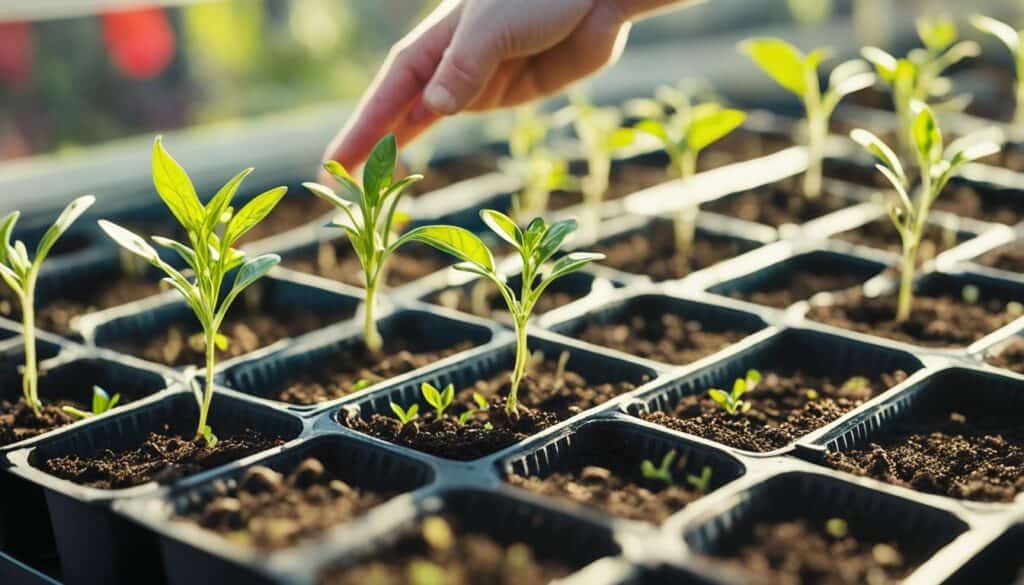
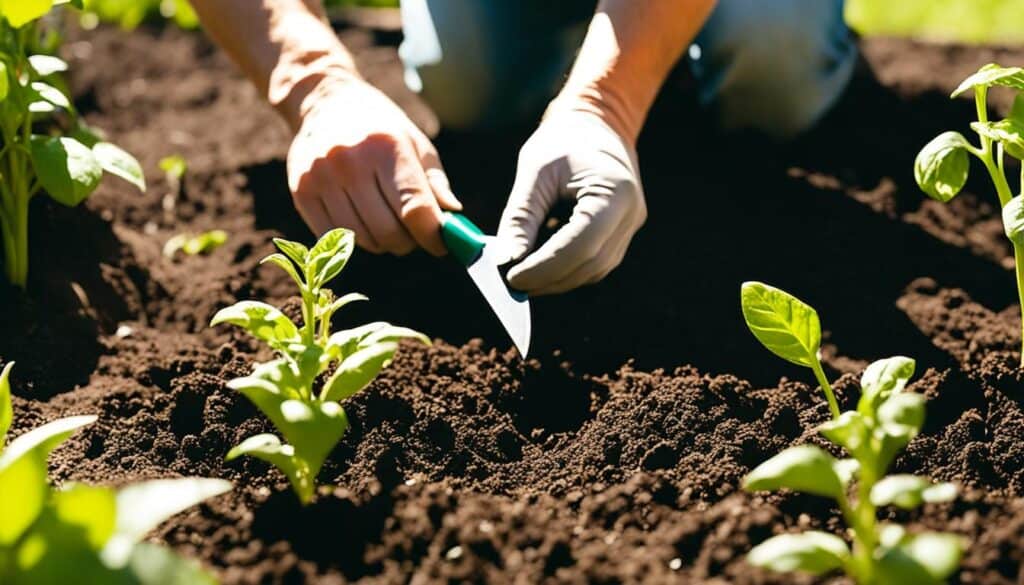
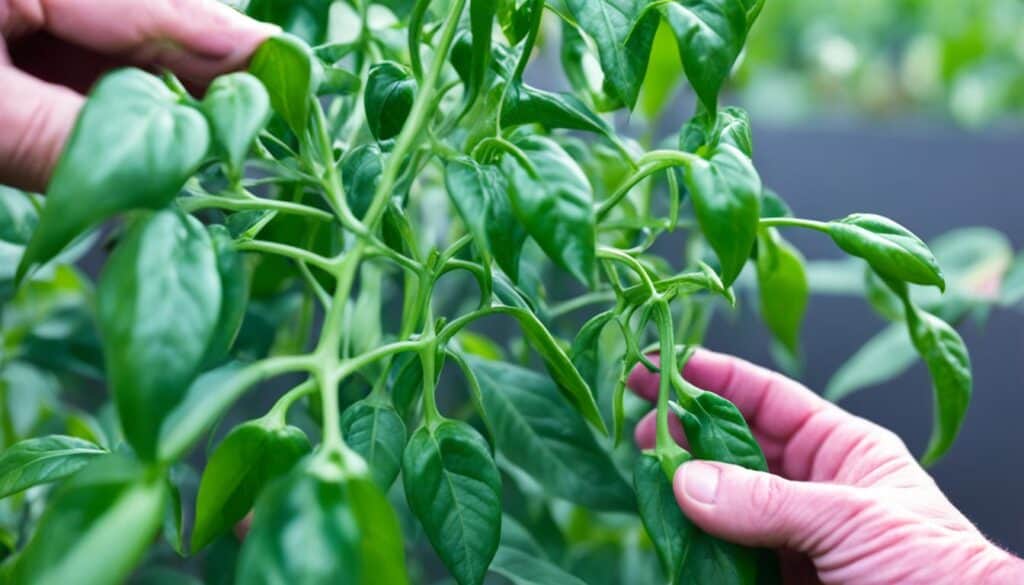
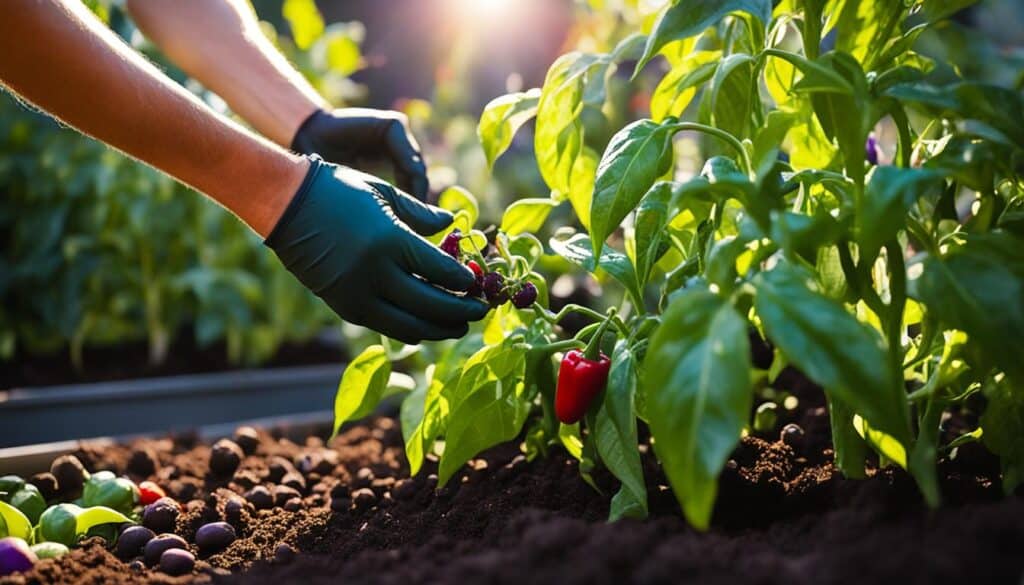
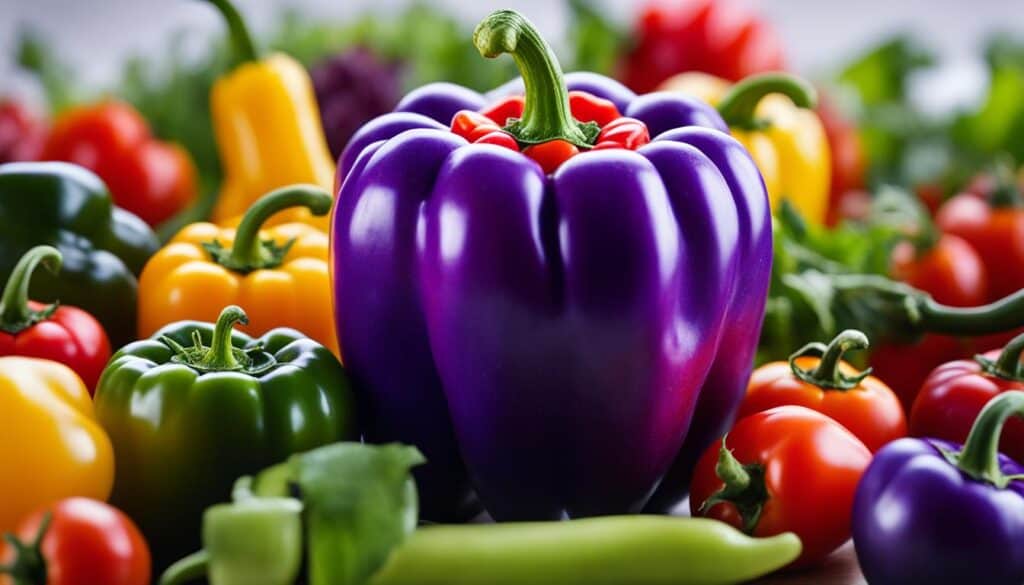



Leave a Reply